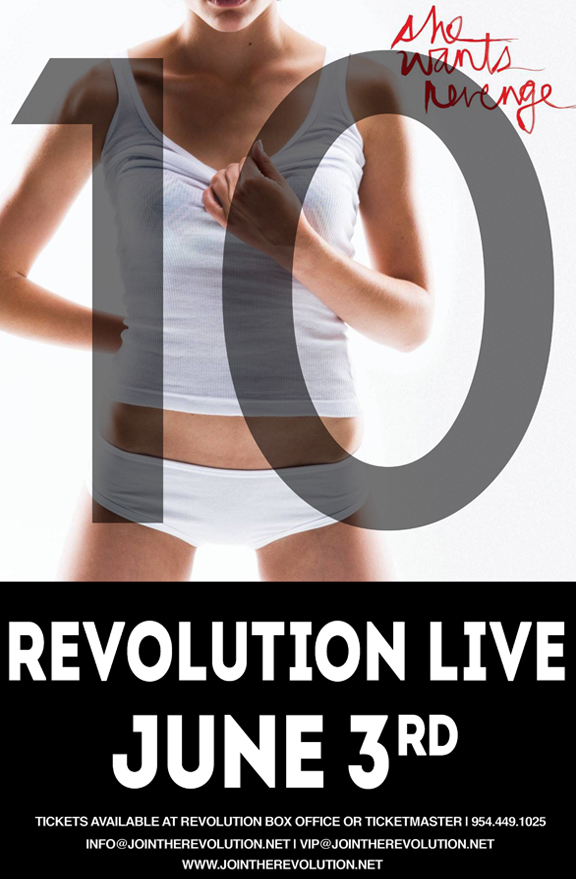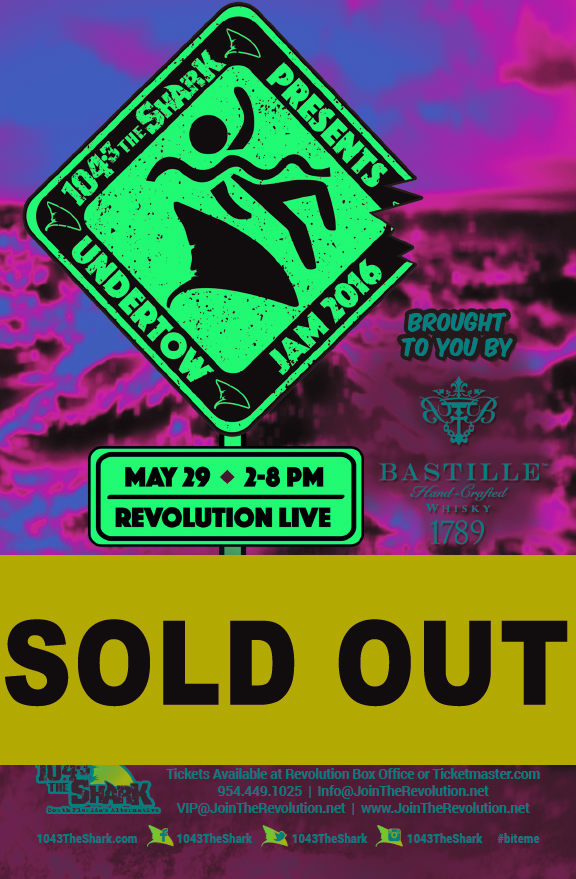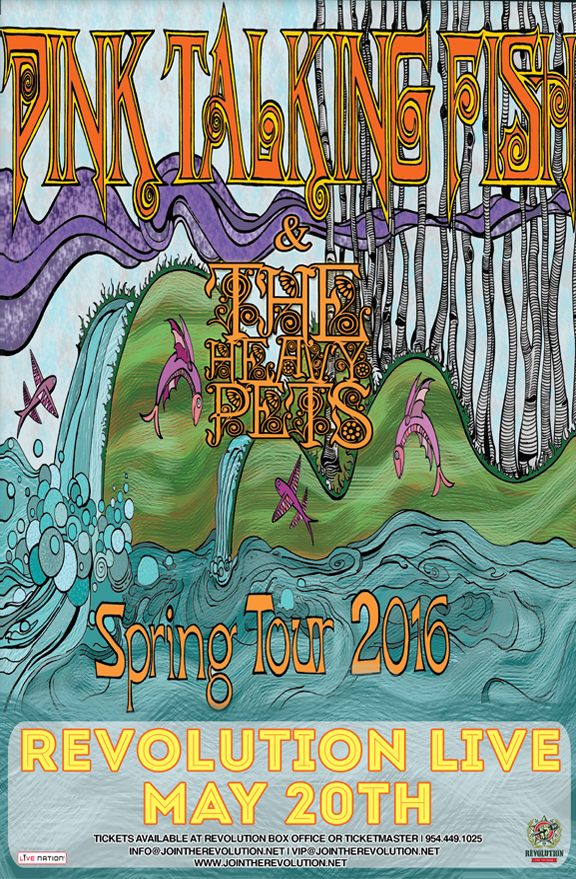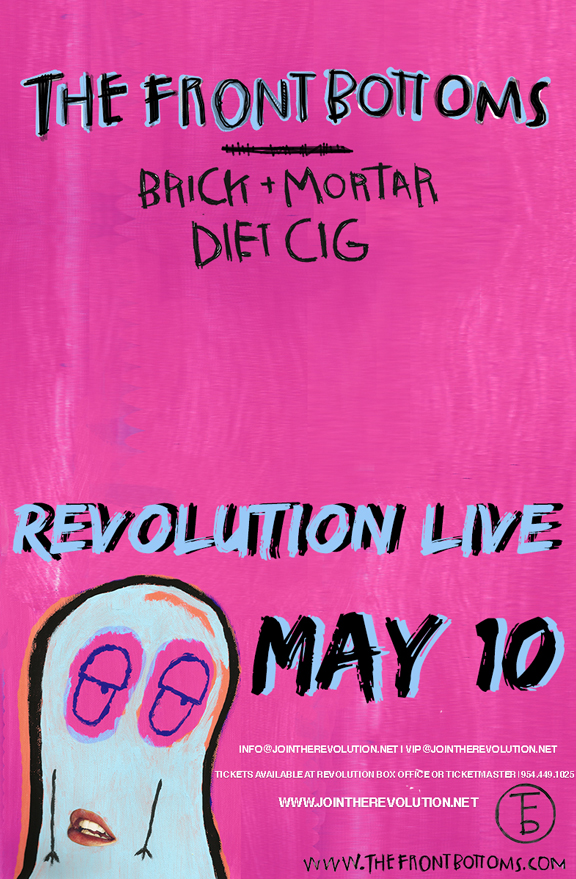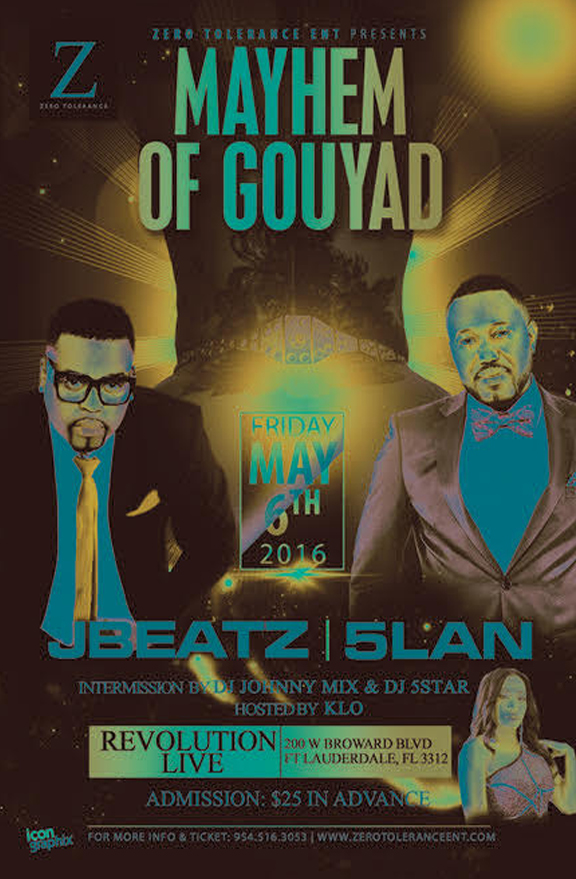Los Angeles DJs Justin Warfield and Adam “Adam 12” Bravin formed the moody, Joy Division-inspired She Wants Revenge in 2003. A fortuitous combination of word of mouth, industry connections, and airplay on Sirius Satellite Radio and West Coast airwave giant KCRW provided the duo with enough exposure to snag a record deal with Geffen, resulting in a 2006 self-titled release that drew comparisons toInterpol, early Depeche Mode, and the Bravery, as well as their aforementioned eternally depressed post-punk heroes from England. After touring with Depeche Mode, they returned with 2007’s This Is Forever. She Wants Revengethen issued two EPs, 2008’s Save Your Soul and the following year’s Up & Down. A tour with the Psychedelic Furs led the way for the band’s third album, Valleyheart, in 2011.
Undertow Jam 2016 ft: Young The Giant
Young the Giant write the sort of soaring, melodic rock ‘n’ roll that’s bound for greatness. From the jolting percussion and anthemic chorus of “My Body” to the lovesick fervor of “Cough Syrup” to the uptempo, sun-stained pop of “I Got,” the California five-piece’s stunning debut features an arresting collection of songs that announce the presence of a vital new band. “Islands” marries off-kilter jazz rhythms with vocalist Sameer Gadhia’s haunting falsetto to create an unnerving effect; the electric slide guitar that punctuates “Street Walker” shrouds the song’s dance beats in mystery; and it’s impossible to interpret the wall of chiming guitars in “Twelve Fingers” as anything less than pure joy. Young the Giant play big songs with big ideas, and they’re not shy about it. Consider the chorus of “Guns Out,” where Gadhia sings pointed, disconsolate lyrics over a devastating crescendo of noise: “You’ll drive in my car/ just tell me we are going somewhere/ where the stars meet the sky/ And all these people with small dreams / are looking up at the big screen/ Well, am I wrong or am I right?”
Possessing a well-honed song craft that usually belongs to far more seasoned musicians, the band’s members only range in age from 20 to 22. Comprised of Gadhia, Jacob Tilley (guitar), Eric Cannata (guitar/vocals), Payam Doostzadeh (bass) and Francois Comtois (drums/vocals), Young the Giant present a diverse set of musical ideas, one that’s as varied as their ethnic backgrounds—Indian, Persian, British and French-Canadian among them. But they share a sophisticated sensibility and they’re all natives of Orange County. If they sound polished, it’s because they’ve been playing music together since high school. “We all started writing music when we were really young,” says Gadhia. “I thought it was interesting to play in random dive bars around Orange County when I was 16. Being that age and seeing how music worked was interesting. Everyone embraced each other. It was a big community of friends.”
Although they developed their skills at shows around Irvine and Newport Beach, it wasn’t until Gadhia and Tilley started college that the band began to turn into something more than a hobby. “Jacob and Sameer would come down from college in Northern California and we’d try new material at shows,” Comtois says. “That’s how we’d gauge the songs we were working on—the response from the audiences.” The overwhelmingly positive response convinced them that they should pursue music full-time. The band recorded the Shake My Hand EP, a seven-song collection that includes a version of “Cough Syrup,” which became a favorite on KROQ. On the strength of their newfound following, the band embarked on a 2009 tour and caught the attention of Roadrunner Records. After opening up for the Whigs and Kings of Leon at Chicago’s House of Blues and making a pit stop at South by Southwest, the band signed with Roadrunner in August 2009.
For most of the past year and a half – when they weren’t on tour – the musicians lived in Newport Beach and Los Angeles, writing and recording their full-length debut. They also acquired a new name. Formerly known as the Jakes, they began calling the band Young the Giant in January of 2010. “We started when we were 16, 17 years old, and our true writing capabilities came later,” says Gadhia. “We wanted to play under a new moniker that all of us felt equally comfortable with.” (Gadhia also explains that the name is purposefully nonsensical, a “leftfield idea” meant to evoke curiosity. On the band’s MySpace blog, he points to the Brothers Grimm fairytale, “The Young Giant,” as a happy accident.) To begin writing, they moved into a house together on the ocean in Newport Beach, which they say provided inspiration for the album. “It’s about freedom, making music that we like playing,” says Comtois. “That’s what we experienced at the beach. Listening to the album represents to me what we’ve been through over the past couple of years.” Gadhia agrees: “A lot of the ideas on the record spawned from our time there—that concept of eternal summer, of youthfulness.”
They lived on the beach for about seven months, then relocated to a West Hollywood apartment that served as both their living quarters and creative space. It was then that the band began working with producer Joe Chiccarelli, whose work for artists like the White Stripes, the Raconteurs and My Morning Jacket they admired. (My Morning Jacket’s Bo Koster guests on keys on several of the album’s tracks; Roger Manning, keyboardist for Beck, plays here on “Your Side.”) They tracked most of the songs live at Sunset Sound Studios in LA, which they found initially daunting but were pleased with the results. “Joe demands a lot of his players,” says Comtois. “There was an element of us stepping up.” Says Gadhia, “He brought out the best in us in a lot of ways. I don’t think anyone can compete with his level of precision. I think it really worked because there was a combination of his skill with our energy.”
Between recording sessions at Sunset Sound Studios and Kingsize Studio in LA with Chiccarelli and mixing sessions at Electric Lady Studios in NYC with Michael Brauer (Coldplay, My Morning Jacket) in mid 2010, Young the Giant toured the country with Minus the Bear and Steel Train. As fond as they are of their work in the studio, they find themselves equally drawn to playing live—another venue for them to work out their ideas. “The road is like being on a constant adventure,” Comtois says. “I look at it like the way Kerouac saw America, going from town to town. If you’re in a band, that’s the closest thing to that type of lifestyle and that energy carries over to the live show, especially because we’re all friends. We so enjoy playing with each other and we’ve been jamming for so long, even if we’re on stage, it’s the act of playing music together first and foremost that’s so awesome.”
Fat Joe
Latino rapper Fat Joe (aka Fat Joe da Gangsta, Joey Crack, and his real name, Joe Cartagena) was raised in the South Bronx area of New York. It was through an older brother that Cartagena learned the ways of the street, as well as discovering rap music via the sounds of such groundbreaking artists as Theodore, Funky 4 + 1, and the Furious Five. Eventually going by the name of Fat Joe, the rapper secured a recording contract with the Relativity label in the early ’90s, resulting in the release of his full-length debut, Represent, in 1993 (which spawned the single “Flow Joe,” peaking at the number one spot on Billboard’s Hot Rap Singles chart). Two years later, Fat Joe issued his sophomore effort, Jealous One’s Envy, which included a cameo by KRS-One, as well as production contributions by the likes of DJ Premier, L.E.S., and Domingo. Around the same time, Fat Joe appeared on LL Cool J’s big hit “I Shot Ya” (along with Foxy Brown and Keith Murray) and collaborated with Wu-Tang Clan’s Raekwon on a track from the “Envy” single called “Firewater.”
By the late ’90s, Fat Joe had switched record labels (signing on with Atlantic) and tried his hand at other non-musical-career ventures such as opening a clothing store called Fat Joe’s Halftime, a barber shop, and a fashion line, FJ560. In addition, he signed a production and distribution deal with Atlantic Records and Mystic Entertainment (which he ran with a partner named Big Greg). Fat Joe’s debut for Atlantic, 1998’s Don Cartagena, featured cameo appearances by the likes of Puff Daddy, Nas, Raekwon, Big Pun, and Jadakiss (the LOX), and was followed up in 2001 with Jealous Ones Still Envy (J.O.S.E.), which included contributions from Ludacris, Petey Pablo, M.O.P., R. Kelly, and Remy. Loyalty followed in 2002, then in 2004, he had a major hit with his crew Terror Squad when “Lean Back” landed with vocals from crew member Remy Ma. The raw Me, Myself and I from 2006 found the rapper on his own Terror Squad imprint, which was distributed by EMI. His second album for the label, The Elephant in the Room, appeared in 2008. A year later, Jealous Ones Still Envy arrived with a star-studded guest list. In 2010, the “(Ha Ha) Slow Down,” single announced the coming of that year’s The Darkside. The album was the rapper’s first release for the E1 label. In 2016, he reunited with Terror Squad member Remy Ma for “All the Way Up,” a single featuring French Montana as special guest.
Millencolin
True Brew is an album self-recorded by the band, mixed by Jens Bogren at Fascination Street Studios, produced by vocalist/bassist Nikola Sarcevic and Färm in Soundlab Studios, with all artwork, photography and music videos created by guitarist Erik Ohlsson. It’s clear the band members are just as unified as they were when they formed Millencolin, roughly 23 years, seven albums and 1,500 live shows ago. “We’re a band truly formed from respect and understanding for each other and our passion for rock music,” explains Sarcevic. “If you ask us, this is the best job in the world!”
The new material musically draws upon some of Millencolin’s earliest influences like Bad Religion through galloping drums and fast, technical riffing, the album lyrically tackles modern sociopolitical issues in ways the band never have before. Take standout track “Sense & Sensibility,” which Sarcevic wrote about the growing problem of nationalist and racist political parties in his native Sweden. True Brew is the kind of album that sounds both timeless and modern, a record that could only come out of four adults who have been side by side since they were teenagers, who have weathered changing politics, shifting cultures and the rise and fall of all kinds of musical trends. Most bands never make it this far in their careers, at least not without a handful of ex-members, lawsuits and various skeletons in their respective closets. And one listen to True Brew will tell you that Millencolin are back, they’re as strong as they’ve been in a decade or more and they’ve never lost that fire.
Pink Talking Fish with The Heavy Pets
Pink Talking Fish is a Hybrid Tribute Fusion Act that takes the music from three of the world’s most beloved bands and creates a special treat for fans of the music.
Pink Floyd, The Talking Heads and Phish are all more than just bands… they are Phenomenons. Their creations have artistically inspired people and their mindblowing live performances have brought people together to form a special sense of community around the love for their favorite band.
Although the music from each act is different, Pink Talking Fish has discovered that fusing the material together creates an amazing story. The epic emotion of Pink Floyd…. The funky, danceable layerings of The Talking Heads…. The multitude of styles, unique compositional structures and pure fun of Phish…. to merge these three into one gives music lovers a special experience.
Pink Talking Fish features Eric Gould on bass, Richard James on keyboards, Zack Burwick on drums and Dave Brunyak on guitar. This is a band created by musicians who love the music of these acts. It’s purpose is to heighten people’s passion for this music by creating something fresh and exciting for fans.
Discovering connections is part of the fun: Pink Floyd’s “On The Run” seamlessly fitting in the middle of the composition of Phish’s “You Enjoy Myself”. Perfectly placing Phish’s “Sand” into the groove of The Talking Head’s “Slippery People”. Segued collections from all three acts such as Run Like Hell > Making Flippy Floppy > Piper > Run Like Hell or Mike’s Song > Have A Cigar > Once In A Lifetime > Weekapaug Groove. These ideas are the spirit behind Pink Talking Fish.
The story is ever evolving. The experience is always exciting. Come join Pink Talking Fish for the ultimate fusion tribute and celebrate the love of this music in unique fashion.
Flatbush Zombies
The Brooklyn crew comprised of Meechy Darko, Zombie Juice, and Erick Arc Elliott made their Internet debut as Flatbush Zombies with a video that celebrated two of their favorite things: weed and waffles. The duo flashed gold fangs at the camera, smoked L’s like its legal, and ate waffles next to Sour Diesel nuggets.
Next came a viral spark that got the attention of hip-hop blogs and a few major labels, but it didn’t stop there. After a string of trippy videos for “S.C.O.S.A.”and “Face-Off (L.S. Darko),” Flatbush Zombies released their first full-length mixtape,D.R.U.G.S., last week. From Kilo Kish’s magnetic appearance on “JupiterSound” to the syrupy, smoked-out “Laker Paper,” D.R.U.G.S. is every bit a strange smoker’s album as it is an introduction to the left-field collective.
On the heels of spitting fiery verses on A$AP Mob’s “Bath Salt,” we decided it was time to find out Who Is Flatbush Zombies? During a visit to the Zombie Palace, the crew kept the weed in heavy rotation while they played quick rounds of NBA 2K12. As expected, rap talk was plentiful, but the conversation also drifted to the meaning of “zombie,” movie influences, “Thug Waffle” hate, and why they can’t stop wearing Supreme. Continue reading for a look at it all and a better understanding of who these rising rappers really are.
The Front Bottoms
The Front Bottoms are an indie rock duo from New Jersey whose music is a wildly eclectic blend of pop, rock, and punk influences, accompanied by witty lyrics that offer a rapid-fire, slightly surreal perspective on the world around them. The Front Bottoms are vocalist Brian Sella on guitars and vocals and Mathew Uychich on drums and bullhorn. Hailing from Bergen County, New Jersey, Sellaand Uychich have been friends since they were ten years old, and started writing songs together whenSella was in sixth grade. After years of making music on their own, Sella and Uychich decided to take their act to the stage at a high-school talent show, where they played an original song as well as aModest Mouse cover. Sella‘s mother hoped to encourage the boys by buying them some time at a local recording studio, where they managed to record 12 songs in just three hours. With enough original songs to play a set, the Front Bottoms were booked to play an all-ages show at a club in Pompton Lakes, New Jersey with a handful of local bands; there they met Casey Lee Morgan, who was running sound that night and recorded music in his home studio.
Morgan began doing sessions with the duo, and in 2008 the Front Bottoms put out a self-released album, I Hate My Friends, and they hit the road, making their way up and down the East Coast and playing any makeshift venue that would have them. Another D.I.Y. album, My Grandmother vs. Pneumonia, was released in 2009, and an EP appeared in 2010. Early on in their touring exploits, Brian Uychich (Mathew‘s brother) joined the duo on keyboards and vocals, but he left the group in 2011 to pursue his education, and the Front Bottoms continued on without him. In 2011 the Front Bottoms signed a deal with respected New Jersey independent label Bar/None Records, and their first album for their new sponsors, simply titled The Front Bottoms, was issued in September 2011. They followed it up with 2013’s Talon of the Hawk, and in 2014 released a six-song EP of previously unreleased fan favorites titled Rose, which is supposedly the first in a series of EPs to be named after the bandmembers’ grandmothers. In April 2015 they released a split EP called Liberty and Personality with rapper GDP, followed by their third studio album, the Fueled by Ramen-issued Back on Top, in September of that year.
Mayhem of Gouyad
Featuring JBeatz and 5LAN
Intermission by DJ Johnny Mix & DJ 5Star
Event is from 11pm – 4am
Cypress Hill
Cypress Hill were notable for being the first Latino hip-hop superstars, but they became notorious for their endorsement of marijuana, which actually isn’t a trivial thing. Not only did the group campaign for its legalization, but their slow, rolling bass-and-drum loops pioneered a new, stoned funk that became extraordinary influential in ’90s hip-hop — it could be heard in everything from Dr. Dre’s G-funk to the chilly layers of English trip-hop. DJ Muggs crafted the sound, and B Real, with his pinched, nasal voice, was responsible for the rhetoric that made them famous. The pro-pot position became a little ridiculous over time, but there was no denying that the actual music had a strange, eerie power, particularly on the band’s first two albums. Although B Real remained an effective lyricist and Muggs’ musical skills did not diminish, the group’s third album, Temples of Boom, was perceived by many critics as self-parodic, and the group appeared to disintegrate shortly afterward, though Muggs and B Real regrouped toward the end of the ’90s to issue more material.
DVX, the original incarnation of Cypress Hill, formed in 1986 when Cuban-born brothers Sen Dog (born Senen Reyes, November 20, 1965) and Mellow Man Ace hooked up with fellow Los Angeles residents Muggs (born Lawrence Muggerud, January 28, 1968) and B Real (born Louis Freese, June 2, 1970). The group began pioneering a fusion of Latin and hip-hop slang, developing their own style by the time Mellow Man Ace left the group in 1988. Renaming themselves Cypress Hill after a local street, the group continued to perform around L.A., eventually signing with Ruffhouse/Columbia in 1991.
With its stoned beats, B Real’s exaggerated nasal whine, and cartoonish violence, the group’s eponymous debut became a sensation in early 1992, several months after its initial release. The singles “How I Could Just Kill a Man” and “The Phuncky Feel One” became underground hits, and the group’s public pro-marijuana stance earned them many fans among the alternative rock community. Cypress Hill followed the album with Black Sunday in the summer of 1993, and while it sounded remarkably similar to the debut, it nevertheless became a hit, entering the album charts at number one and spawning the crossover hit “Insane in the Brain.” With Black Sunday, Cypress Hill’s audience became predominantly white, collegiate suburbanites, which caused them to lose some support in the hip-hop community. The group didn’t help matters much in 1995, when they added a new member, drummer Bobo, and toured with the fifth Lollapalooza prior to the release of their third album, Temples of Boom. A darker, gloomier affair than their first two records, Temples of Boom was greeted with mixed reviews upon its fall 1995 release, and while it initially sold well, it failed to generate a genuine hit single. However, it did perform better on the R&B charts than it did on the pop charts.
Instead of capitalizing on their regained hip-hop credibility, Cypress Hill slowly fell apart. Sen Dog left in early 1996 and Muggs spent most of the year working on his solo album. Muggs Presents the Soul Assassins was released to overwhelmingly positive reviews in early 1997, leaving Cypress Hill’s future in much doubt until the release of IV in 1998. Sen Dog had come back for the record. He had left because he felt he did not get enough mike time, but after a few years with a rock band he was more than happy to return. Two years later, the group released the double-disc set Skull & Bones, which featured a disc of hip-hop and a disc of their more rock-inspired material. Appropriately, the album also included rock and rap versions of the single “Superstar,” bringing Cypress Hill’s quest for credibility and crossover hits full circle. The ensuing videos for both versions featured many famous rap and rock musicians talking about their profession, and the song was a smash on MTV because of it. In the winter of 2001, the group came back with Stoned Raiders, another album to heavily incorporate rock music. Three years later, the band issued Till Death Do Us Part, which incorporated several styles of Jamaican music. In 2010 they announced their signing to Priority Records thanks to the label’s creative director, Snoop Dogg. The label released their eighth studio album, Rise Up, that same year.
Ra Ra Riot
After being a band for a decade, it’s easy to get disillusioned with the tedium of adulthood, but Need Your Light, the fourth full-length from RaRa Riot, is the sound of a band being reinvigorated by their own existence. Correspondingly, the album sees the group—which originated in Syracuse but has now dispersed all over the country—getting back to their house party roots without abandoning the more heady soundscapes they explored with 2013’s Beta Love. The result is an album that’s celebratory without being saccharine, and that sees the group collectively mining their prior experiences to craft something that looks toward the future with an optimistic gaze.
The original plan was for the band—which features vocalist Wes Miles, bassist Mathieu Santos, guitarist Milo Bonacci, violinist Rebecca Zeller and drummer Kenny Bernard—to take the first extended break of their career after the year and a half they spent on the road supporting Beta Love. After a few months, however, they couldn’t help themselves from working on new music. “The inspiration came very quickly,” Miles says, explaining that he decided to fly out to Los Angeles to start fleshing out ideas with previous producer Dennis Herring (Modest Mouse, Elvis Costello). Shortly afterward, the group went on a writing trip to Milwaukee and began the process of creating what would eventually become Need Your Light. To fully realize their vision, RaRaRiot ended up working with a host of previous collaborators, including Ryan Hadlock (who produced 2008’s debut The Rhumb Line); longtime friend and sound engineer Andrew Maury (who co-produced 2010’s The Orchard); and Vampire Weekend producer Rostam (who is also half of the avant garde R&B duo Discovery alongside Miles).
In fact, Rostam and Miles’ approach to that liberating project—which released its debut LPin 2009—helped influence the end result ofNeed Your Light as well. “In January of this year, Wes came to stay with me on the West Coast for five days, and we set out to write songs not knowing where it would take us,” Rostam explains. “There was something I’d heard in Wes’ singing in the earliest days ofRaRa Riot that I felt had never been captured on record.” Influenced by their shared love of U2’s Achtung Baby, the pair spent five days writing the songs “Water” and “I Need Your Light”. “The attitude of these two songs was only able to come because of over ten years of collaboration,” Miles adds. “These two songs were written with no expectations, and wequickly realized that we wanted them to be played live.” So the duo took another week to record bass, drums, guitar and violin in Los Angeles with the full band.
“Working with people we had a history with was comfortable in the sense that it enabled us to continue growing and focus more on the music than relationships,” Santos adds. “ We already trusted everyone.” Additionally, the group collaborated with previous drummer Gabriel Duquette on the track “Bouncy Castle,” and with longtime friend Maury on“ Absolutely,” “ Call Me Out,” and “ Bad Times,”— further expanding the reoccurring theme onNeed Your Light of a band incorporating their past into the future.
Listening to Need Your Light, it’s quickly apparent that the heightened level of experimentation and expansive soundscapes wouldn’t have been possible without the band’s synth-heavy approach to 2013’s Beta Love. This is clearly evident in the opening track “Water,” which starts off with a syncopated groove and minimalist instrumentation before gradually building into a triumphant, 90’s soul call to arms. Alternately, “Bouncy Castle” resides on the opposite side of the sonic-spectrum with its carefree neo-soul refrain. Yet both of the songs were created with the group’s incendiary live performances in mind. “We wanted to make sure all of the songs on this album could be reproduced live because performing has always been our greatest strength and something we felt we got away from with our last record,” Miles says. “A lot of these songs incorporate the same instrumentation we’ve used in the past, but the vibe is somewhere we haven’t gone before, which is exciting.”
Lyrically, Need Your Light parallels the transitional nature of the members’ lives as they enter their thirties and begin leaving Brooklyn to start families without abandoning the band that they’ve spent their lives cultivating. “It’s more of a grown-up record, but with our still invariably raucous attitude,” Miles explains, adding that this evolution was entirely organic. In other words, the aforementioned “ Bouncy Castle” may revolve around an adolescent’s first erection, but it’s not merely an attempt at humor. “On this album we talk about serious things in kind of a funny context, but it’s presented very earnestly,” Santos says. “We really tried to have that type of balance and dichotomy on all of these songs.”
From the carefree, orchestrally tinged vibe of “Absolutely” to the shimmering falsetto pop of “Instant Breakup,” Need Your Light sees the band mining their career to come up with songs that transcend categorization. This ability to get back in touch with their roots was only encouraged by their decision todo a short tour of warehouses and basements late last year before they reentered the studio. The experience reminded them of why they began RaRa Riot in the first place. “Because we started as a house party band, we never wanted to lose sight of having fun and engaging with the audience through visceral live shows,” Santos says.
n the past RaRa Riot have latched onto cerebral concepts like the Singularity or futurism, but with this album they cast a wider net, focusing on everything from sexual relationships to the Challenger explosion. “ It was fun to write songs about Internet affairs and retain a kind of tech-aspect, but it’s much more understated,” Miles explains. The stories are conveyed in such a way that it leaves the listener the chance to attach a more personal meaning to each of the 10 tracks. Whether Miles is singing about something fantastic or mundane, there’s an enduring energy to the songs onNeed Your Light, which illustrates that in many ways, RaRa Riot are still only getting started.
Jason Derulo
HITS 97.3 Presents #HITSSessions Starring Jason Derulo at Revolution Live (official) in Downtown Fort Lauderdale, Wednesday night April 27th! The ONLY Way In Is To WIN! This event is 18+
Santigold
As a solo project with a revolving door of members, the heart and face of Santigold is vivacious frontwoman Santi White. White and John Hill, her former counterpart from ska-punk band Stiffed, use their common backgrounds as production-savvy musicians to make bombastic, bass-oriented songs that fuse punk, reggae, grime, and indie rock with electro. Tribal island rhythms merge with flavorful digital chirps and blips, culminating in an original sound that is comparable to M.I.A. but draws from too many other influences to be considered just another M.I.A. knockoff.
While showcasing her array of vocal styles at a Stiffed show, White was spotted by Martin Heath, who made her an offer to record a solo record on Lizard King, the label responsible for the successful promotion of the Killers. After failed attempts with a few mainstream pop producers, White and Hill(now calling the project Santogold) decided to pair up with a crew of like-minded musicians — includingFreq Nasty, Disco D, Switch, Spank Rock‘s Naeem, Xxxchange, Steel Pulse guitarist Clifford Moonie Pusey, and none other than M.I.A. herself.
In only three weeks, the full-length Creator was completed and scheduled for release in January of 2008, though it took until April for the album (retitled simply Santogold) to actually hit shelves. She spent time supporting headlining acts ranging from Coldplay to Jay-Z for the rest of the year. Then Whitedecided to change the name of the project to Santigold in early 2009 for reasons related to an impending lawsuit from wrestler and “personality” Santo Gold. Although a follow-up under the new name was not immediately forthcoming, she kept busy featuring on tracks by N.A.S.A. (The Spirit of Apollo), Beastie Boys (Hot Sauce Committee, Pt. 2), andthe Lonely Island (Turtleneck & Chain). She started recording solo again in January 2010. Once the dynamic sophomore follow-up was completed, the release date was delayed when she briefly joined and left Jay-Z‘s Roc-a-Fella Records, but eventually she signed with Atlantic Records, and Master of My Make-Believe was unveiled in April of 2012.
